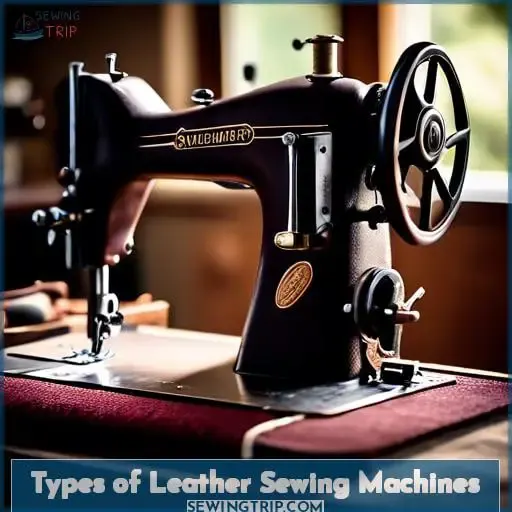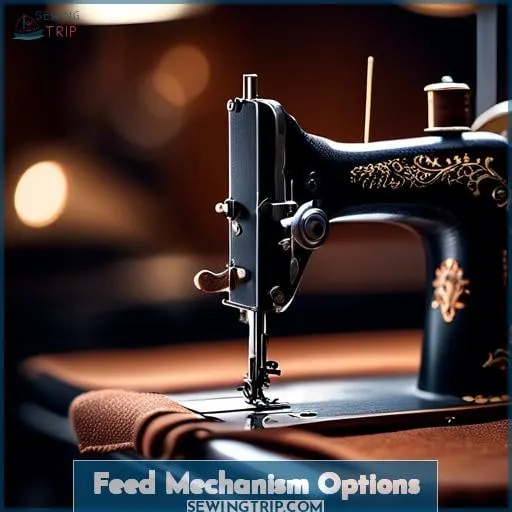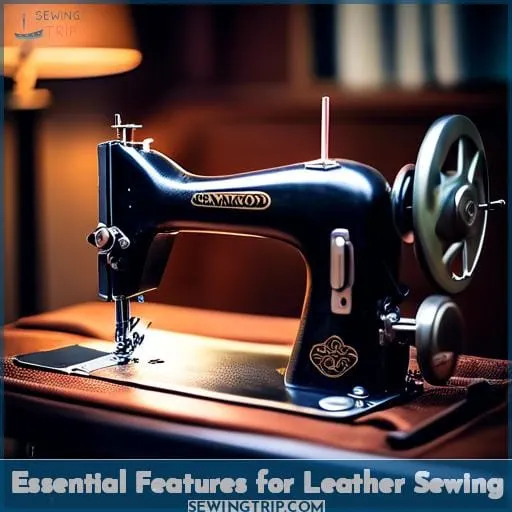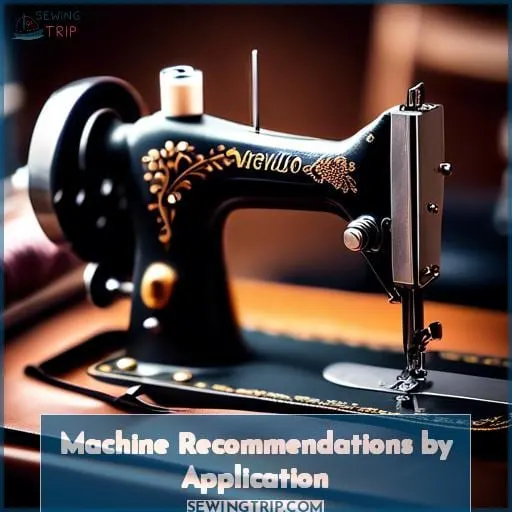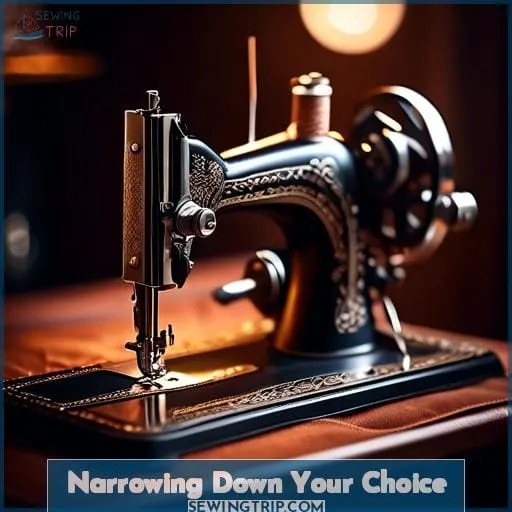This site is supported by our readers. We may earn a commission, at no cost to you, if you purchase through links.
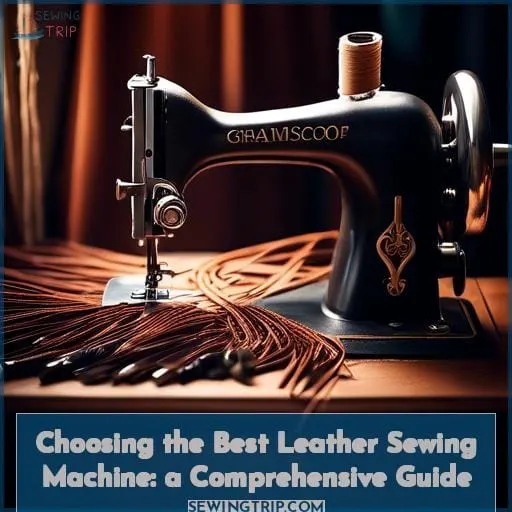 Selecting the right leather sewing machine can elevate your craftsmanship and efficiency.
Selecting the right leather sewing machine can elevate your craftsmanship and efficiency.
You’ll need a machine that matches your projects, whether you’re stitching wallets or upholstering furniture.
Consider machine types, feed mechanisms, and essential features like sewing thickness and motor power.
This guide will help you navigate these choices with confidence, ensuring you invest in a machine that meets your leatherworking demands and enhances your creative potential.
Let’s dive into how to choose the best leather sewing machine for your needs.
Table Of Contents
Key Takeaways
- Consider the type of leather sewing machine that best suits your needs, such as cylinder arm, flatbed, or post bed machines, each offering different benefits for specific applications.
- Evaluate the feed mechanism options like compound feed, drop feed, or needle feed, which will affect how the material moves through the machine and the quality of the stitch on leather.
- Ensure the machine has essential features for sewing leather, including the ability to handle the maximum sewing thickness, appropriate thread and needle sizes, and suitable motor specifications for your projects.
- Look for special features and attachments that can enhance your sewing experience, such as a bobbin winder, reverse stitching capability, adjustable stitch length, various presser feet, and tension adjustment.
Types of Leather Sewing Machines
When choosing a leather sewing machine, you’ll encounter three main types: cylinder arm machines, flatbed machines, and post bed machines.
Each type offers unique benefits tailored to different leatherworking projects.
Cylinder Arm Machines
When diving into leather sewing, cylinder arm machines are your secret weapon. Their unique cylinder design and curved form are perfect for stitching 3D structures with ease.
- Compact size fits snugly in your workspace.
- Ideal applications include bags and belts.
- Walking foot ensures smooth fabric feed.
- Generous needle clearance tackles thick leather effortlessly.
Embrace the power of precision with these dynamos.
Flatbed Machines
When tackling large projects, flatbed sewing shines by offering ample surface area for material placement.
Unlike your home sewing machine, a leather sewing machine with a flat bed ensures your leather stays put under the presser foot.
It’s a game-changer for flat items, where performance comparison to cylinder or post bed machines is like comparing apples to oranges.
Post Bed Machines
Diving into post bed machines, think of them as your go-to for tackling those tricky 3D structures.
Unlike the flat expanse of other types, the post bed offers a curved workspace, making it a shoemaker’s dream.
Picture a column rising from the base—this is where magic happens for bags and beyond.
For leather aficionados, it’s a game-changer among leather sewing machine types.
Feed Mechanism Options
When choosing a leather sewing machine, it’s crucial to understand the feed mechanism options available.
Compound Feed / Compound Walking Foot, Drop Feed / Regular Feed, and Needle Feed each offer distinct advantages for handling leather.
Compound Feed / Compound Walking Foot
When you’re stitching wallets or other leather goods, a compound feed with a walking foot is your best pal. It ensures your material won’t stick and dance away like it’s got a mind of its own.
- Walking foot: Keeps layers in check.
- Differential feed: Adjusts for perfect seams.
- Tension adjustment: Fine-tunes stitch harmony.
Drop Feed / Regular Feed
After exploring the compound feed, let’s dive into the drop feed or regular feed mechanism.
| Feature | Importance in Leather Sewing | Tips |
|---|---|---|
| Needle Plate | High | Match with thread size |
| Presser Foot | Crucial | Adjust for thickness |
| Tension Adjustment | Key | Fine-tune for stitch length |
Needle Feed
After mastering drop feed, you’ll find needle feed to be a game-changer for your leather projects.
- Consistent stitch length on heavy-duty materials
- Improved tension regulation
- Precise needle choice for varying leather thicknesses
Essential Features for Leather Sewing
When choosing a leather sewing machine, it’s crucial to consider the machine’s maximum sewing thickness and the sizes of threads and needles it can accommodate.
Look for models with powerful motors and special features like attachments that suit your specific leatherworking needs.
Maximum Sewing Thickness
After diving into feed mechanisms, let’s tackle maximum sewing thickness. Your leather sewing machine’s capacity to handle various leather thicknesses is crucial.
Whether you’re stitching thin, delicate skins or tough, medium-duty hides, the right machine ensures smooth needle penetration without a hitch.
It’s about matching the machine’s sewing capacity with your project’s material flexibility and fabric weight.
Thread and Needle Sizes
After tackling the challenge of maximum sewing thickness, let’s dive into the nuts and bolts of thread and needle sizes.
Your leather sewing machine craves the right combo: a sturdy nylon thread paired with a sharp denim needle.
Think of thread strength as your project’s backbone and needle gauge as the precision tool.
Getting thread tension just right? That’s the secret sauce.
Motor Specifications
When diving into the world of leather sewing, the motor of your machine is your secret weapon.
- Motor speed ensures you keep pace, without skipping a beat.
- Motor efficiency means less energy waste, more sewing.
- Motor torque tackles thick leather like a hot knife through butter.
- Motor durability and noise levels: because who needs a racket while crafting masterpieces?
Special Features and Attachments
When choosing a leather sewing machine, don’t skimp on the bells and whistles. A bobbin winder saves time, while reverse stitching and adjustable stitch length give you control over every seam.
Swap out presser feet for the task at hand, and fine-tune with tension adjustment. It’s like having a Swiss Army knife for leatherwork—versatile and ready for anything from satchels to saddles.
Machine Recommendations by Application
When selecting a leather sewing machine, it’s crucial to match the machine’s capabilities with the specific items you plan to create.
For instance, if you’re aiming to craft bags, wallets, or upholstery, you’ll need a machine that can handle the intricacies and thickness of these products.
Bags, Wallets, and Upholstery
After diving into the essentials, let’s tackle your projects head-on.
For crafting bags, wallets, and upholstery, you’ll need a leather sewing machine that can handle rounded corners, internal seams, and delicate materials with grace.
The Adler and Singer sewing machines shine here, offering the precision for curved shapes and the versatility in thread choice to bring your vision to life.
Leather Garments and Belts
When crafting leather garments and belts, your sewing machine must be up to the task. Opt for a machine like Leatherwork® or a sturdy vintage Singer, ensuring it can handle the right needle size and thread choice, especially cotton for its durability.
Adjust the bobbin tension for smooth stitches, select a presser foot that won’t stick, and set a stitch length that complements the leather’s thickness.
Heavy Duty Items Like Saddle Bags
After mastering belts and wallets, you’re ready to tackle the big leagues: saddle bags, gun holsters, and more.
Choosing the right leather sewing machine becomes crucial. Look for machines that can handle the toughness of these projects, like the 4100 or 5100 series.
Perfecting tension adjustment and stitch design will make your work stand out.
Custom Shoes and Sneakers
When diving into the craft of custom sneakers, picking the right leather sewing machine is key.
- Custom patterns: Look for machines that allow creativity to flow.
- Size flexibility: Ensure it can handle various shoe sizes.
- Narrow toe design: A must for sleek sneaker profiles.
- Intricate stitching: Precision is your friend.
- Heel height adjustment: Because one size doesn’t fit all.
Narrowing Down Your Choice
When choosing the best leather sewing machine, it’s crucial to consider the type of leather and its thickness you’ll be working with.
You’ll also need to decide on the right feed mechanism and evaluate other features like motor power and special attachments to ensure the machine meets your specific needs.
Assessing Leather Type and Thickness
When choosing a leather sewing machine, don’t play it by ear; consider leather density and puncture resistance.
Thicker hides demand a machine that can handle the extra grunt. Remember, tensile strength and grain direction affect how leather behaves under stress—some stretch more than a yoga instructor!
So, pick a machine that won’t throw a fit over a bit of stretch.
Selecting the Right Feed Mechanism
Selecting the right feed mechanism is like choosing the best dance partner for leather’s tango. It’s all about harmony and avoiding those awkward steps where material sticking becomes a problem.
- Walking feet keep the rhythm, ensuring smooth moves without tripping over.
- High foot lift allows for quick costume changes between thick and thin materials.
- Presser feet guide each step, preventing any missteps on the dance floor.
Evaluating Motor Power and Special Features
When choosing a leather sewing machine, motor power isn’t just about speed—it’s the muscle for thick hides.
Special features and add-ons, like attachments for unique stitches, can be game-changers.
It’s like picking a car; power’s great, but can you handle the tune-ups?
Comparing Machines for Specific Applications
When zeroing in on the perfect leather sewing machine for your projects, think about the end game.
A cylinder arm machine might be your ally for tight spots, while a drop feed excels in straightforward stitching. Don’t overlook special features; they can turn a tough job into a walk in the park.
Frequently Asked Questions (FAQs)
How do I maintain a leather sewing machine?
Keep your leather sewing machine humming by regularly dusting the bobbin case.
Oil moving parts with the right oil to ensure smooth operation.
Avoid water-based cleaners as they can damage the machine.
Can I upgrade parts of my leather sewing machine?
Yes, you can upgrade parts of your leather sewing machine, turning it into a trusty steed that gallops through projects with ease.
Think of it as arming your knight for battle, ensuring victory stitch by stitch.
What is the average lifespan of a leather sewing machine?
Leather sewing machines can last a lifetime with proper care. On average, expect a span of 10 to 25 years.
How does humidity affect leather sewing machines?
Humidity’s a sneaky beast, wreaking havoc on your leather sewing machine by rusting metal parts and messing with thread and fabric behavior.
Keep it in check with a dehumidifier to avoid unexpected sewing adventures.
Are there eco-friendly leather sewing machines available?
Yes, eco-friendly leather sewing machines are available. They are like a breath of fresh air for the environmentally conscious crafter. These machines feature energy-efficient motors and sustainable materials, aligning your sewing passion with green practices.
Conclusion
Just as a needle threads through leather, creating a bond that holds, your choice in a leather sewing machine stitches together your craft and ambition.
By considering the types of machines, feed mechanisms, and essential features, you’ve equipped yourself to select the best leather sewing machine for your projects.
Now, take this knowledge and let your craftsmanship flourish.

